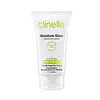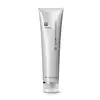What's inside
What's inside
 Key Ingredients
Key Ingredients

 Benefits
Benefits

 Concerns
Concerns

 Ingredients Side-by-side
Ingredients Side-by-side

Water
Skin ConditioningDimethicone
EmollientCaprylic/Capric Triglyceride
MaskingGlycerin
HumectantButylene Glycol
HumectantCetyl Alcohol
EmollientGlyceryl Stearate
EmollientPrunus Amygdalus Dulcis Oil
Skin ConditioningCitrus Limon Peel Oil
MaskingLaminaria Ochroleuca Extract
Skin ConditioningRuscus Aculeatus Root Extract
AstringentCentella Asiatica Extract
CleansingAloe Barbadensis Leaf Juice
Skin ConditioningAesculus Hippocastanum Seed Extract
Skin ConditioningCalendula Officinalis Flower Extract
MaskingCamellia Sinensis Leaf Extract
AntimicrobialLavandula Hybrida Oil
EmollientButyrospermum Parkii Butter
Skin ConditioningPhenoxyethanol
PreservativePolysorbate 80
EmulsifyingAcrylamide/Sodium Acryloyldimethyltaurate Copolymer
Emulsion StabilisingPEG-75 Stearate
Isohexadecane
EmollientChlorphenesin
AntimicrobialSclerotium Gum
Emulsion StabilisingXanthan Gum
EmulsifyingCeteth-20
CleansingSteareth-20
CleansingTocopheryl Acetate
AntioxidantPanthenol
Skin ConditioningAllantoin
Skin ConditioningTetrasodium EDTA
Propylene Glycol
HumectantSorbitan Oleate
EmulsifyingCitric Acid
BufferingEscin
TonicSodium Hyaluronate
HumectantAmmonium Glycyrrhizate
MaskingHydrolyzed Yeast Protein
Skin ConditioningSodium Citrate
BufferingPotassium Sorbate
PreservativeSodium Benzoate
MaskingWater, Dimethicone, Caprylic/Capric Triglyceride, Glycerin, Butylene Glycol, Cetyl Alcohol, Glyceryl Stearate, Prunus Amygdalus Dulcis Oil, Citrus Limon Peel Oil, Laminaria Ochroleuca Extract, Ruscus Aculeatus Root Extract, Centella Asiatica Extract, Aloe Barbadensis Leaf Juice, Aesculus Hippocastanum Seed Extract, Calendula Officinalis Flower Extract, Camellia Sinensis Leaf Extract, Lavandula Hybrida Oil, Butyrospermum Parkii Butter, Phenoxyethanol, Polysorbate 80, Acrylamide/Sodium Acryloyldimethyltaurate Copolymer, PEG-75 Stearate, Isohexadecane, Chlorphenesin, Sclerotium Gum, Xanthan Gum, Ceteth-20, Steareth-20, Tocopheryl Acetate, Panthenol, Allantoin, Tetrasodium EDTA, Propylene Glycol, Sorbitan Oleate, Citric Acid, Escin, Sodium Hyaluronate, Ammonium Glycyrrhizate, Hydrolyzed Yeast Protein, Sodium Citrate, Potassium Sorbate, Sodium Benzoate
Water
Skin ConditioningHoney Extract
HumectantC12-15 Alkyl Benzoate
AntimicrobialDimethicone
EmollientHydroxyethyl Acrylate/Sodium Acryloyldimethyl Taurate Copolymer
Emulsion StabilisingEthoxydiglycol
HumectantButylene Glycol
HumectantIsohexadecane
EmollientCyclopentasiloxane
EmollientEthylhexyl Palmitate
EmollientPolymethyl Methacrylate
Hibiscus Abelmoschus Extract
MaskingChenopodium Quinoa Seed Extract
Skin ConditioningPalmitoyl Oligopeptide
CleansingCetyl Alcohol
EmollientEchinacea Purpurea Extract
MoisturisingAlgae Extract
EmollientCyclohexasiloxane
EmollientHelianthus Annuus Seed Oil
EmollientSodium Hyaluronate
HumectantPEG-8
HumectantIlex Paraguariensis Leaf Extract
PerfumingPEG-7 Trimethylolpropane Coconut Ether
EmulsifyingSqualane
EmollientSteareth-20
CleansingTocopheryl Acetate
AntioxidantLaminaria Digitata Extract
Skin ProtectingAloe Barbadensis Leaf Juice
Skin ConditioningSorbitan Isostearate
EmulsifyingPolyisobutene
PEG-75 Stearate
Glyceryl Stearate
EmollientPolysorbate 60
EmulsifyingCeteth-20
CleansingGlyceryl Polymethacrylate
Disodium EDTA
Aminomethyl Propanol
BufferingParfum
MaskingPhenoxyethanol
PreservativeChlorphenesin
AntimicrobialWater, Honey Extract, C12-15 Alkyl Benzoate, Dimethicone, Hydroxyethyl Acrylate/Sodium Acryloyldimethyl Taurate Copolymer, Ethoxydiglycol, Butylene Glycol, Isohexadecane, Cyclopentasiloxane, Ethylhexyl Palmitate, Polymethyl Methacrylate, Hibiscus Abelmoschus Extract, Chenopodium Quinoa Seed Extract, Palmitoyl Oligopeptide, Cetyl Alcohol, Echinacea Purpurea Extract, Algae Extract, Cyclohexasiloxane, Helianthus Annuus Seed Oil, Sodium Hyaluronate, PEG-8, Ilex Paraguariensis Leaf Extract, PEG-7 Trimethylolpropane Coconut Ether, Squalane, Steareth-20, Tocopheryl Acetate, Laminaria Digitata Extract, Aloe Barbadensis Leaf Juice, Sorbitan Isostearate, Polyisobutene, PEG-75 Stearate, Glyceryl Stearate, Polysorbate 60, Ceteth-20, Glyceryl Polymethacrylate, Disodium EDTA, Aminomethyl Propanol, Parfum, Phenoxyethanol, Chlorphenesin
Ingredients Explained
These ingredients are found in both products.
Ingredients higher up in an ingredient list are typically present in a larger amount.
Aloe Barbadensis Leaf Juice comes from leaves of the aloe plant. Aloe Barbadensis Leaf Juice is best known for helping to soothe sunburns. It is also anti-inflammatory, moisturizing, antiseptic, and can help heal wounds.
Aloe is packed with good stuff including Vitamins A, C, and E. These vitamins are antioxidants, which help fight free-radicals and the damage they may cause. Free-radicals are molecules that may damage your skin cells, such as pollution.
Aloe Barbadensis Leaf Juice also contains sugars. These sugars come in the form of monosaccharides and polysaccharides, folic acid, and choline. These sugars are able to help bind moisture to skin.
It also contains minerals such as calcium, 12 anthraquinones, fatty acids, amino acids, and Vitamin B12.
Learn more about Aloe Barbadensis Leaf JuiceButylene Glycol (or BG) is used within cosmetic products for a few different reasons:
Overall, Butylene Glycol is a safe and well-rounded ingredient that works well with other ingredients.
Though this ingredient works well with most skin types, some people with sensitive skin may experience a reaction such as allergic rashes, closed comedones, or itchiness.
Learn more about Butylene GlycolWe don't have a description for Ceteth-20 yet.
Cetyl Alcohol is a fatty alcohol. Fatty Alcohols are most often used as an emollient or to thicken a product.
Its main roles are:
Though it has "alcohol" in the name, it is not related to denatured alcohol or ethyl alcohol.
The FDA allows products labeled "alcohol-free" to have fatty alcohols.
Learn more about Cetyl AlcoholChlorphenesin is a synthetic preservative. It helps protect a product against bacteria in order to extend shelf life. In most cases, Chlorphenesin is paired with other preservatives such as phenoxyethanol and caprylyl glycol.
Chlorphenesin is a biocide. This means it is able to help fight the microorganisms on our skin. It is also able to fight odor-releasing bacteria.
Chlorphenesin is soluble in both water and glycerin.
Studies show Chlorphenesin is easily absorbed by our skin. You should speak with a skincare professional if you have concerns about using Chlorphenesin.
Learn more about ChlorphenesinDimethicone is a type of synthetic silicone created from natural materials such as quartz.
What it does:
Dimethicone comes in different viscosities:
Depending on the viscosity, dimethicone has different properties.
Ingredients lists don't always show which type is used, so we recommend reaching out to the brand if you have questions about the viscosity.
This ingredient is unlikely to cause irritation because it does not get absorbed into skin. However, people with silicone allergies should be careful about using this ingredient.
Note: Dimethicone may contribute to pilling. This is because it is not oil or water soluble, so pilling may occur when layered with products. When mixed with heavy oils in a formula, the outcome is also quite greasy.
Learn more about DimethiconeGlyceryl Stearate is a mix of glycerin and stearic acid.
It is used to stabilize the mixing of water and oil ingredients. By preventing these ingredients from separating, it can help elongate shelf life. It can also help thicken the product's texture.
As an emollient, it helps soften skin and supports barrier-replenishing ingredients.
In cosmetics, Glyceryl Stearate is often made from vegetable oils or synthetically produced.
This ingredient may not be fungal-acne safe
Fun fact: The human body also creates Glyceryl Stearate naturally.
Learn more about Glyceryl StearateIsohexadecane is added to enhance texture, emulsify, and to help cleanse. It is an isoparrafin. It is a component of petrolatum.
Due to its large size, Isohexadecane is not absorbed by the skin. Instead, it sits on top and acts as an emollient. Emollients help keep your skin soft and smooth by trapping moisture within.
Isohexadecane is often used in products designed to help oily skin. It is lightweight and non-greasy while helping to moisturize. When mixed with silicones, it gives a product a silky feel.
Learn more about IsohexadecanePEG-75 Stearate isn't fungal acne safe.
Phenoxyethanol is a preservative that has germicide, antimicrobial, and aromatic properties. Studies show that phenoxyethanol can prevent microbial growth. By itself, it has a scent that is similar to that of a rose.
It's often used in formulations along with Caprylyl Glycol to preserve the shelf life of products.
Sodium Hyaluronate is hyaluronic acid's salt form. It is commonly derived from the sodium salt of hyaluronic acid.
Like hyaluronic acid, it is great at holding water and acts as a humectant. This makes it a great skin hydrating ingredient.
Sodium Hyaluronate is naturally occurring in our bodies and is mostly found in eye fluid and joints.
These are some other common types of Hyaluronic Acid:
Learn more about Sodium HyaluronateSteareth-20 is a waxy compound used to emulsify ingredients. It is created from stearyl alcohol.
It possesses surfactant properties. This means it reduces surface tension and helps oils, dirt, and pollutants to be washed away.
The 20 stands for the number of ethylene oxide used to create this ingredient.
Learn more about Steareth-20Tocopheryl Acetate is AKA Vitamin E. It is an antioxidant and protects your skin from free radicals. Free radicals damage the skin by breaking down collagen.
One study found using Tocopheryl Acetate with Vitamin C decreased the number of sunburned cells.
Tocopheryl Acetate is commonly found in both skincare and dietary supplements.
Learn more about Tocopheryl AcetateWater. It's the most common cosmetic ingredient of all. You'll usually see it at the top of ingredient lists, meaning that it makes up the largest part of the product.
So why is it so popular? Water most often acts as a solvent - this means that it helps dissolve other ingredients into the formulation.
You'll also recognize water as that liquid we all need to stay alive. If you see this, drink a glass of water. Stay hydrated!
Learn more about Water